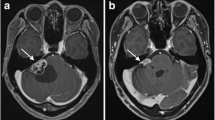Abstract
Background
Advances in various diagnostic and/or treatment modalities, including radiological imaging, neuromonitoring, and microsurgical techniques, have resulted in treatments of vestibular schwannomas being aimed at preserving facial and hearing functions while achieving optimal tumor control.
Method
We describe our surgical technique for hearing preservation in vestibular schwannoma surgery.
Conclusion
The retrosigmoid transmeatal approach under continuous neuromonitoring (auditory brainstem response, cochlear nerve action potentials, and continuous facial nerve monitoring) enables gross-total resection of vestibular schwannomas, while preserving hearing and facial functions. Radiological assessment and microsurgical techniques, such as meticulous tumor dissection, are also essential for functional preservation with sufficient tumor removal.




Similar content being viewed by others
Abbreviations
- ABR:
-
Auditory brainstem response
- CN:
-
Cranial nerve
- CNAP:
-
Cochlear nerve action potentials
- CT:
-
Computed tomography
- MRI:
-
Magnetic resonance imaging
- SEP:
-
Somatosensory evoked potential
References
Amano M, Kohno M, Nagata O, Taniguchi M, Sora S, Sato H (2011) Intraoperative continuous monitoring of evoked facial nerve electromyograms in acoustic neuroma surgery. Acta Neurochir 153:1059–1067 discussion 1067
Kohno M, Sato H, Sora S, Miwa H, Yokoyama M (2011) Is an acoustic neuroma an epiarachnoid or subarachnoid tumor. Neurosurgery 68(4):1006–1016
Kohno M, Sora S, Sato H, Shinogami M, Yoneyama H (2015) Clinical features of vestibular schwannomas in patients who experience hearing improvement after surgery. Neurosurg Rev 38(2):331–341 discussion 341
Matsushima K, Kohno M, Nakajima N (2019) Retrosigmoid intradural temporal bone drilling for intrapetrous chondrosarcoma extending to cerebellopontine angle. World Neurosurg 122:28
Matsushima K, Kohno M, Nakajima N, Ichimasu N (2019) Dorsally displaced facial nerve in retrosigmoid transmeatal approach for vestibular schwannoma: 3-dimensional operative video. World Neurosurg. 123:300
Nejo T, Kohno M, Nagata O, Sora S, Sato H (2016) Dorsal displacement of the facial nerve in acoustic neuroma surgery: clinical features and surgical outcomes of 21 consecutive dorsal pattern cases. Neurosurg Rev 39(2):277–288
Quiñones-Hinojosa A, Chang EF, Lawton MT (2006) The extended retrosigmoid approach: an alternative to radical cranial base approaches for posterior fossa lesions. Neurosurgery. 58(4 Suppl 2):ONS-208-214 discussion ONS-214
Sasaki T, Shono T, Hashiguchi K, Yoshida F, Suzuki SO (2009) Histological considerations of the cleavage plane for preservation of facial and cochlear nerve functions in vestibular schwannoma surgery. J Neurosurg 110(4):648–655
Shao KN, Tatagiba M, Samii M (1993) Surgical management of high jugular bulb in acoustic neurinoma via retrosigmoid approach. Neurosurgery. 32(1):32–36 discussion 36-37
Wanibuchi M, Fukushima T, Friedman AH, Watanabe K, Akiyama Y, Mikami T, Iihoshi S, Murakami T, Sugino T, Mikuni N (2014) Hearing preservation surgery for vestibular schwannomas via the retrosigmoid transmeatal approach: surgical tips. Neurosurg Rev 37(3):431–444 discussion 444
Acknowledgments
We thank Ms. Miki Hioki and Mr. Yoshifumi Kawaguchi for their support as medical technologists.
Author information
Authors and Affiliations
Corresponding author
Ethics declarations
Informed consent
Informed consent was obtained from a participant included in this study.
Conflict of interest
The authors declare that they have no conflict of interest.
Additional information
Key Points
- Sufficient craniotomy and dural opening for minimizing cerebellar retraction
- Combination of ABR and CNAP for continuous and stable hearing assessment
- Early start of and careful observation of continuous facial nerve monitoring
- Safe transmeatal drilling with sufficient irrigation
- Electrically activated dissectors for safe and prompt facial nerve identification inside the internal acoustic meatus
- Subperineurial tumor dissection in a semi-sharp fashion
- Maximum resection of the intrameatal tumor to prevent later recurrence
- Intraoperative decision-making for a balance between maximum tumor resection and functional preservation based on neuromonitoring
- Microscopic dural closure to prevent postoperative cerebrospinal fluid leakage
- Careful follow-up examination, particularly in cases with intentional near-total removal for functional preservation
Publisher’s note
Springer Nature remains neutral with regard to jurisdictional claims in published maps and institutional affiliations.
This article is part of the Topical Collection on Tumor - Schwannoma
Electronic supplementary material
This video shows hearing preservation surgery for a left vestibular schwannoma via the retrosigmoid transmeatal approach under ABR, CNAP, and continuous facial nerve monitoring. (MP4 237191 kb)
Rights and permissions
About this article
Cite this article
Matsushima, K., Kohno, M. & Nakajima, N. Hearing preservation in vestibular schwannoma surgery via retrosigmoid transmeatal approach. Acta Neurochir 161, 2265–2269 (2019). https://doi.org/10.1007/s00701-019-04034-9
Received:
Accepted:
Published:
Issue Date:
DOI: https://doi.org/10.1007/s00701-019-04034-9




